Introduction
To understand demand and supply concepts, different writers have developed various ideas through which they can achieve useful understanding. For example, in a work scenario, the supply curve is primarily determined by the quantity of work an individual is willing to supply forgiven a task. For instance, if one asks people to dig a 20m2 piece of land for $10, a given number of people may be willing to supply their labor (Boggs, 2002). However, many people will consider the price too low for such a tiresome amount of work. However, more people will be willing to work on that particular piece of land if the price was increased to at least $100. In this case, it means that people will increase their interest in performing a particular task depending on the amount of cash offered. However, some factors affect the supply curve making it either shift from right to left or back. These factors may involve technology, productivity, and the cost of items, amongst other factors. For instance, if the workers can apply technology and dig the piece of land within the duration that could have been taken if more workers worked on the same area, then the curve will shift to the right.
The law of supply indicates that the quantity of goods rises when the price in the market is raised and also falls when the prices fall in the market. The law of demand, on the other hand, suggests that when the price of a product rises, its quantity is reduced and vice versa. Various determinants of demand are involved in the world of economics. They include; expectations, income buyers, preferences, price of the product as well as the price of the related goods.
Increase/Decrease Demand
A better understanding of the increase or decrease in demand can be achieved by considering how the various curves relate to one another. Demand curve- in economics, the demand is estimated by the application of multiple factors that help determine whether a given product can be in high order when produced for the particular populace. For instance, for the demand to increase, the consumers are required to be willing and able to buy a specific product. The period that the buyers are ready and willing to buy a given product is also considered when examining demand (Boggs, 2002). The relationship between the demand and quantity demanded is always inversely oriented. The equilibrium, on the other hand, is the condition in the market where supply is equal to demand. In the graph below, the equilibrium is marked by the meeting point of the supply curve and the demand curve.
Synopsis/Situation
This paper utilizes the principles of microeconomics to identify ways in which segmentation can be achieved in a world of customers with different preferences and demands in a refreshments company manufacturing soft drinks. As elaborated by Kumar (2010), the buyer's common desires are grouped together and placed under different categories during the market segmentation process. Segmenting marketing has been an ever continuous debate over the years, mainly on the parameters that ought to be taken to account while subdividing the market. There are various factors that have been identified as key determinants during the identification and segmentation of markets. Those factors include brand loyalty, individual factors social and economic factors.
Shifts
In a manufacturing organization, the demand curve is likely to shift from one side of the graph to the other. As the quality increases, the price per bottle is expected to increase, making the demand curve alter its cause. Such changes are defined as the elasticity of demand. Flexibility is the process of determining the response observed in the quantity demand of a particular good as a result of a positive change initiated on products from an organization within the same industry (price). The entire procedure will help us determine two factors regarding the similarity of the products provided. For example, when the cost of a given good goes up, the demand curve is likely to shift to the left. This means that the demand for that given product has gone down due to the increased price of the good (Cooper, 2003). Elasticity aims at determining how much the demand curve would shift right, or to the left, after an increase in price. The formula for calculating the elasticity of a given good is obtained by dividing the percentage change in demand by the percentage change in the cost of the other product.
References
Wedel, M., & Kamakura, W. A. (2000). Market segmentation: Conceptual and methodological foundations. Boston: Kluwer Academic.
Michman, R. D. (1991). Lifestyle market segmentation. New York: Praeger.
Dibb, S. (1996). The market segmentation workbook: Target marketing for marketing managers. Thomson
Bernardo, R. S., Scanell, J., & Zepf, D. (2001). U.S. Patent No. 6,219,680. Washington, DC: U.S. Patent and Trademark Office
Boggs, W., & Boggs, M. (2002). Mastering UML with rational rose 2002. Sybex.Cooper, J. C. (2003). Price elasticity of demand for crude oil: estimates for 23 countries. OPEC Review, 27(1), 1-8.Easterlin, R. A. (2005). Diminishing marginal utility of income? Caveat emptor. Social: Indicators Research, 70(3), 243-255
Cite this page
Demand or Supply? - Paper Example. (2022, Mar 16). Retrieved from https://proessays.net/essays/demand-or-supply-paper-example
If you are the original author of this essay and no longer wish to have it published on the ProEssays website, please click below to request its removal:
- Demand in the Health Care System Essay
- The International Business Environment Paper Example
- Social and Demographic Trends in Workstations Paper Example
- Economic Comparison of Somalia and Venezuela Paper Example
- Essay Example on Evolution of Trade, Tourism, Migration, and Remittances in the Region
- Research Paper on Globalization & Climate Change: The Interconnectedness of Ecosystems
- Tariffs: Taxes, Protectionism, and Globalization - Essay Sample







